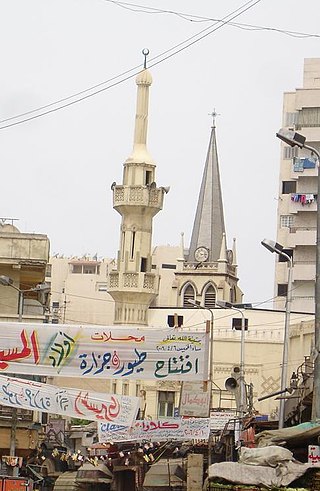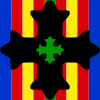
The Coptic Orthodox Church,, also known as the Coptic Orthodox Patriarchate of Alexandria, is an Oriental Orthodox Christian church based in Egypt. The head of the church and the See of Alexandria is the pope of Alexandria on the Holy Apostolic See of Saint Mark, who also carries the title of Father of fathers, Shepherd of shepherds, Ecumenical Judge and the 13th among the Apostles. The See of Alexandria is titular. The Coptic pope presides from Saint Mark's Coptic Orthodox Cathedral in the Abbassia District in Cairo. The church follows the Coptic Rite for its liturgy, prayer and devotional patrimony. Adherents of the Coptic Orthodox Church make up Egypt's largest and most significant minority population, and the largest population of Christians in the Middle East and North Africa (MENA). They make up the largest percentage of approximately 20 million Christians in Egypt

Pope Shenouda III was the 117th Pope of Alexandria and Patriarch of the See of St. Mark. His papacy lasted 40 years, 4 months, and 4 days, from 14 November 1971 until his death.

Copts are a Christian ethnoreligious group indigenous to North Africa who have primarily inhabited the area of modern Egypt since antiquity. They are the largest Christian denomination in Egypt and the Middle East, as well as in Sudan and Libya. Copts in Egypt account for roughly 5–15 percent of the Egyptian population; Copts in Sudan account for 1 percent of the Sudanese population, while Copts in Libya similarly account for 1 percent of the Libyan population.

Religion in Egypt controls many aspects of social life and is endorsed by law. The state religion of Egypt is Islam, although estimates vary greatly in the absence of official statistics. Since the 2006 census religion has been excluded, and thus available statistics are estimates made by religious and non-governmental agencies. The country is majority Sunni Muslim, with the next largest religious group being Coptic Orthodox Christians. The exact numbers are subject to controversy, with Christians alleging that they have been systemically under-counted in existing censuses.

Christianity is the second largest religion in Egypt. The vast majority of Egyptian Christians are Copts. As of 2019, Copts in Egypt make up approximately 10 percent of the nation's population, with an estimated population of 9.5 million or 10 million. In 2018, approximately 90% of Egyptian Christians were Coptic Orthodox.

The Monastery of Saint Fana is a Coptic Orthodox monastery. It is named after Saint Fana, also known as Bane, Coptic Christian hermit. The monastery is sometimes called the Monastery of Abu Fanah and is also known as the Monastery of the Cross, due to the presence of many beautifully decorated crosses inside its church.

The persecution of Copts and discrimination against Coptic Orthodox Christians are historic and widespread issues in Egypt. Their treatment is indicative of the poor status of Christians in the Middle East more widely, despite the fact that the religion is native to the Middle East, and that Christianity in Egypt dates back to the Roman era. Copts are the indigenous Christians in Egypt, usually Oriental Orthodox, who currently make up 10% of the population—the largest religious minority of that country. Copts have cited instances of persecution throughout their history and Human Rights Watch has noted "growing religious intolerance" and sectarian violence against Coptic Christians in recent years, as well as a failure by the Egyptian government to effectively investigate properly and prosecute those responsible. However, as political violence is common many churches believe that the attacks against the church are not religious statements, instead political statements. Since 2011, hundreds of Egyptian Copts have been killed in sectarian clashes, and many homes, churches and businesses have been destroyed. In just one province (Minya), 77 cases of sectarian attacks on Copts between 2011 and 2016 have been documented by the Egyptian Initiative for Personal Rights. The abduction and disappearance of Coptic Christian women and girls also remains a serious ongoing problem.
Oriental Orthodoxy is the communion of Eastern Christian Churches that recognize only three ecumenical councils—the First Council of Nicaea, the First Council of Constantinople and the Council of Ephesus. They reject the dogmatic definitions of the Council of Chalcedon. Hence, these Churches are also called Old Oriental Churches or Non-Chalcedonian Churches.
The Islamization of Egypt occurred after the 7th century Arab conquest of Egypt, in which the Islamic Rashidun Caliphate seized control of Egypt from the Christian Byzantine Empire. Egypt and other conquered territories in the Middle East underwent a large scale gradual conversion from Christianity to Islam, accompanied by jizya for those who refused to convert. Islam became the dominant faith by the 10th to 12th centuries, and Arabic replaced Coptic as the vernacular language and Greek as the official language.
The Nag Hammadi massacre was a massacre of Coptic Christians carried out on the eve of 7 January 2010, in the Egyptian city of Nag Hammadi. The massacre occurred at the hands of Muslim gunmen in front of the Nag Hammadi cathedral, as Coptic Christians were leaving the church after celebrating the midnight Christmas Divine Liturgy. The massacre resulted in the murder of eight Copts and one Muslim bystander. Nine other Copts were confirmed to be wounded, and two Muslims were reportedly wounded in the attack. Egypt's Interior Ministry said it suspected the attack was motivated by the alleged rape by a Christian of a Muslim girl.
Kamilia Shehata Zakher is a schoolteacher in Deir Mawas, Egypt, and wife of Tadros Samaan, the Coptic Priest of Saint Mark's Church in Mowas Cathedral in Minya. Her disappearance in July 2010 sparked protests and rumours of kidnapping and forced conversion to Islam. Her subsequent return to the Church inflamed sectarian tensions between Egypt's Muslim majority and Coptic Christian minority.
The 2011 Alexandria bombing was an attack on Coptic Christians in Alexandria, Egypt, on Saturday, 1 January 2011. 23 people died and another 97 were injured as a result of the attack, which occurred as Christian worshipers were leaving a New Year service. The attack was the deadliest act of violence against Egypt's Coptic Christians in a decade, since the Kosheh massacre in 2000 left 20 Copts dead. The target of the bombing was the Saints Church, a Coptic church located across the street from the Masjid Sharq El-Madina mosque.

The Maspero Massacre initially started as demonstrations in October 2011 by a group dominated by Egyptian Copts in reaction to the demolition of a church in Upper Egypt claimed to be built without the appropriate license. The peaceful protesters who intended to stage a sit-in in front of the Maspiro television building were attacked by security forces and the army, resulting in 24 deaths, mostly among the Coptic protestors, and 212 injuries, most of which were sustained by Copts.
Copts in Egypt refers to Coptic Christians born in or residing in Egypt.

Coptic nationalism refers to the nationalism of the Copts, a Christian ethnic and religious minority that primarily inhabit the area of modern Egypt. Coptic nationalism does not have a claim for a Coptic nation but asks for an equal position for Copts in Egypt. Most Copts live in the south of Egypt but the largest concentrations of Copts lives in Cairo and Alexandria. The Copts, like the rest of Egyptians, are descended from the pharaonic inhabitants of Egypt. Most ethnic Copts belongs to the Coptic Orthodox Church. Copts number between 10-15 percent of the Egyptian population of 104 million

On 11 December 2016, a suicide bomber killed 189 people and injured 400+ others at St. Peter and St. Paul's Church, a chapel next to Saint Mark's Coptic Orthodox Cathedral, seat of the Coptic Orthodox Pope, in Cairo's Abbasia district. Egypt's President, Abdel Fattah el-Sisi identified the bomber as 22-year-old Mahmoud Shafiq Mohammed Mustafa, who had worn a suicide vest. el-Sisi reported that three men and a woman have been arrested in connection with the attack; two others are being sought. ISIS claimed responsibility for the attack.
On 26 May 2017, masked gunmen opened fire on a convoy carrying Copts from Maghagha in Egypt's Minya Governorate to the Monastery of Saint Samuel the Confessor, killing at least 33 people and injuring 22 others.
On 29 December 2017, in Helwan, Cairo, Egypt, a gunman opened fire at the Coptic Orthodox Church of Saint Menas and a nearby shop owned by a Coptic man, killing ten citizens and a police officer and injuring around ten people. He was wounded by police and arrested. Investigators said he had carried out several attacks in the last year. Later, Amaq News Agency described that terrorist attack was carried out by a person belonging to the Islamic State group.

The Cathedral of the Nativity of Christ is a Coptic Orthodox cathedral in the as-yet-unnamed New Administrative Capital, Egypt, some 45 km east of Cairo. It was commissioned by the President of Egypt Abdel Fattah el-Sisi and inaugurated on 6 January 2019 by President el-Sisi and the Pope of the Coptic Orthodox Church of Alexandria Tawadros II. It is the largest church in the Middle East, and the largest Oriental Orthodox church in the world by area.
On 2 November 2018, masked gunmen opened fire on a group of Egyptian Christians travelling by bus through Minya. There was a convoy of three vehicles and two of them managed to escape. The vehicles were carrying Copts traveling from Sohag Governorate and Minya Governorate in Egypt to the Monastery of Saint Samuel the Confessor. At least 7 people from Minya were killed while 12 others were injured. A similar attack near the same place had happened in 2017.










